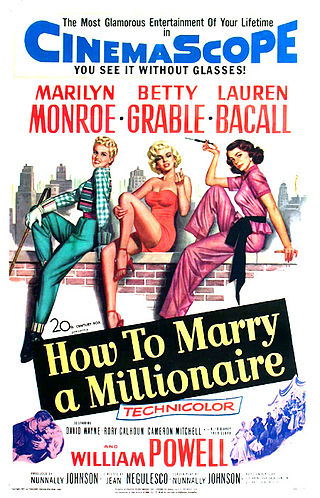Thursday August 13, 2015
Movie Review: How to Marry a Millionaire (1953)
WARNING: SPOILERS
Here’s how dumb I am: I kept waiting for the “Diamonds are a Girl’s Best Friend” number. As the movie began (interminably, with an overture), I also wondered, “Wait, isn’t Jane Russell supposed to be in this?” Of course, I was thinking of “Gentlemen Prefer Blondes,” Marilyn Monroe’s other 1953 hit; but to my credit, “Diamonds” does fit better with this title.
And I did get “Diamonds are a Girl’s Best Friend”—just not as a song.
Halfway through the film, at a private fashion show, Pola (Monroe) is modeling a red swimsuit in front of Tom Brookman (Cameron Mitchell), a gas-pump-jockey-looking rich bastard who is really interested in Schatze Page (Lauren Bacall), and the woman hosting the show says, as Monroe poses, “You know, of course, that diamonds are a girl’s best friend.” Which has got to be one of the quickest pop-cultural-reference turnarounds in history. “Blondes” was released in August and “How to Marry a Millionaire” in November. Did the song get released first? Did screenwriter/producer Nunnally Johnson (“The Grapes of Wrath,” “The Dirty Dozen”) see an early clip and figure it would be an indelible cultural moment?
 The movie is actually full of such sly winks. When Schatze is trying to convince aged Texas oil man J.D. Hanley (William Powell, the least-likely Texas oil man in movie history) that she likes older men, she references Bacall’s real-life husband: “Look at Roosevelt, look at Churchill, look at that old fella, what’s his name, in ‘The African Queen.’” Ditto Loco (Betty Grable), stuck in a picturesque Maine cabin and listening to big-band music on the radio.
The movie is actually full of such sly winks. When Schatze is trying to convince aged Texas oil man J.D. Hanley (William Powell, the least-likely Texas oil man in movie history) that she likes older men, she references Bacall’s real-life husband: “Look at Roosevelt, look at Churchill, look at that old fella, what’s his name, in ‘The African Queen.’” Ditto Loco (Betty Grable), stuck in a picturesque Maine cabin and listening to big-band music on the radio.
Loco: Good old Harry James.
Waldo: Is it? How can you tell?
Loco: How I can tell is because it is Harry James.
James was Grable’s husband. The punchline is that the bandleader they’re listening to is really Ziggy Colombo. Are these girls ever right? Oh, girls.
No means yes
They don’t come off well, do they? Set aside the gold-digging aspect for a moment. Loco mistakes the “lodge” comment of Waldo Brewster (Fred Clark) for an elk’s lodge rather than a romantic tryst, then mistakes forest ranger Eben’s “my trees” comment for vast wealth rather than enthusiastic job responsibility. Schatze, the one who dreams up the scheme of three fashion models subleasing a swanky Upper East Side apartment in order to scam rich husbands, can’t even see the rich man beneath Brookman’s lack of necktie. She thinks he’s a gas-pump jockey like her ex. She doesn’t even question what he’s doing as the sole audience at a private fashion show. She also keeps verbally resisting him (“As soon as I finish this, I never want to see you again”) even as she keeps giving in to him. She’s a “no means yes” girl. Fun times.
Monroe’s Pola, who’s the dingiest of the trio, comes off best by being sweetest. Schatze keeps selling furniture to pay the rent, and dissing Brookman while leading on Hanley; Loco carps the entire time she’s surrounded by beauty; but Pola is nice to everyone. She’s that classic Monroe character: oblivious to her stunning impact. She finally falls for the man who owns the apartment, Freddie Denmark (David Wayne), because he tells her she looks great wearing glasses. (She does.) She’s also the best actor of the three.
It really was Monroe’s moment, wasn't it? Grable, 37, the biggest pinup of World War II, was about to end—she would only make two more movies, then a bit of TV, then nothing—and Bacall, still only 29, never did anything as long-lasting as her work with Bogart in the 1940s. But Monroe, 27, second-billed, became white hot afterwards and never cooled down.
The Greeks have a word for it
The movie is mostly interesting as cultural artifact. You get New York in the early 1950s, America before rock ‘n’ roll and Brown v. Board of Education, and the movie industry doing everything to compete with television. “Millionaire” was the first movie filmed in Cinemascope (but released second, after “The Robe”), and it’s saturated in Technicolor. So it’s wide, colorful ... and flat. And not just the characters. The first act takes place almost completely in that Sutton Place apartment, so you sensed right away that it was based upon a play—specifically “The Greeks Have a World for It” by Zoë Atkins, which debuted in 1930 and was made into a 1932 movie starring Joan Blondell, Madge Evans and Ina Claire, where it was retitled “Three Broadway Girls” to avoid Atkins’ innuendo. It also became a syndicated TV series in the late 1950s, starring Lori Nelson, Merry Anders and a pre-“Jeannie” Barbara Eden.
Could you make the film today? Doubtful. You’d need a different spin. The girls couldn’t be such gold-diggers, not to mention dumb. Not to mention girls.
Baseball's Active Leaders, 2023
What Trump Said When About COVID
Recent Reviews
Everything Everywhere All at Once (2022)
Black Panther: Wakanda Forever (2022)
Doctor Strange in the Multiverse of Madness (2022)
Spider-Man: No Way Home (2021)
The Cagneys
A Midsummer Night's Dream (1935)
Something to Sing About (1937)
Angels with Dirty Faces (1938)
A Lion Is In the Streets (1953)
Man of a Thousand Faces (1957)
Never Steal Anything Small (1959)
Shake Hands With the Devil (1959)







